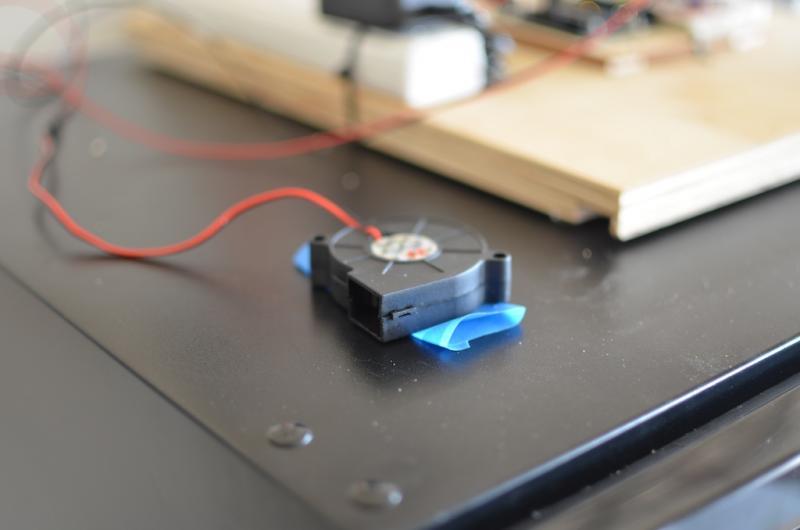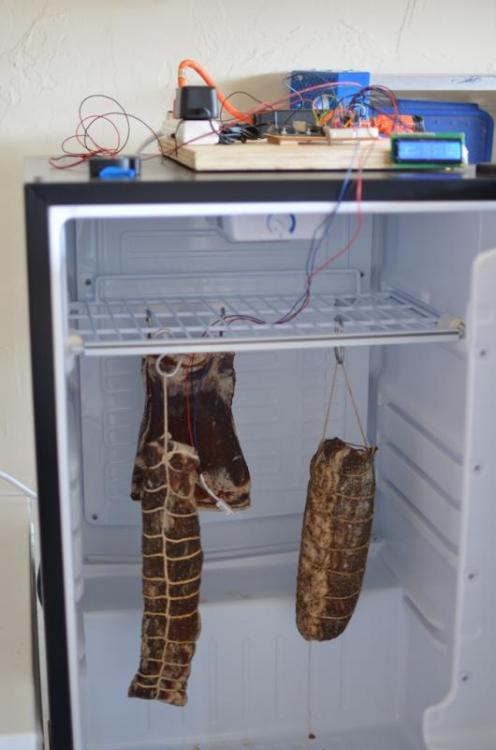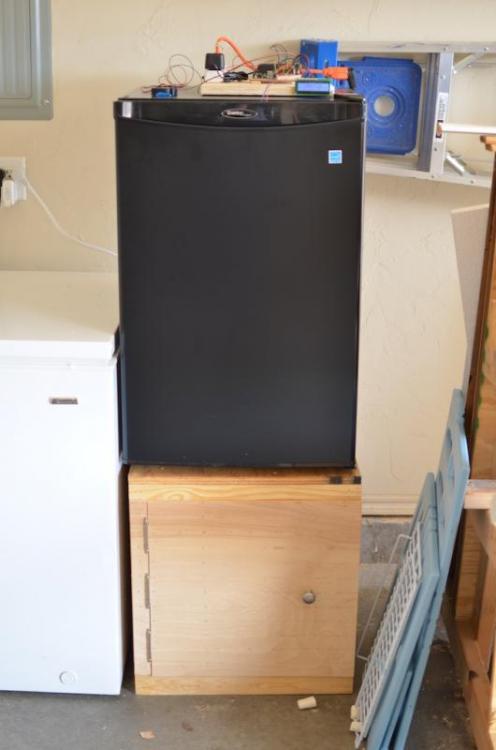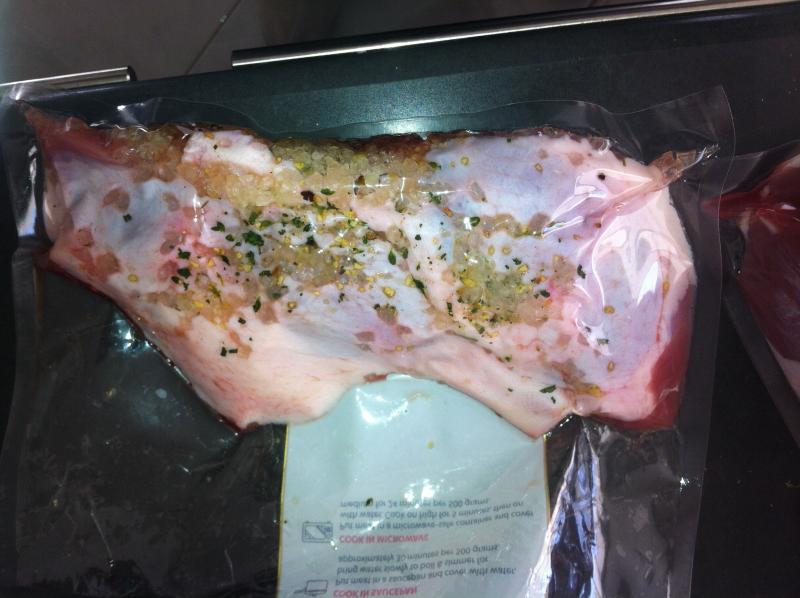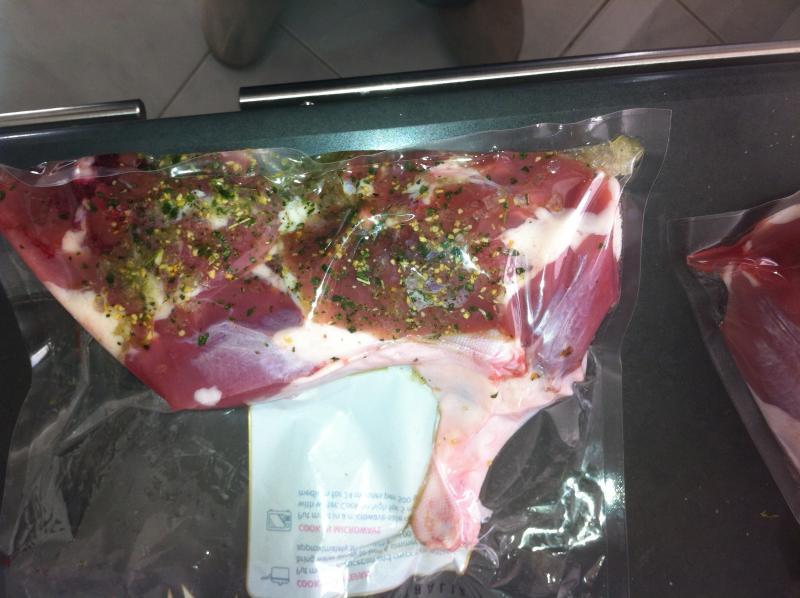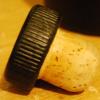Search the Community
Showing results for tags 'Charcuterie'.
-
We made some salami a couple of months back using the pork from our berkshire pigs (which we rear on our orchard). We followed Hugh Fearnley-Whittingstall's advice in the River Cottage Cookbook, using LS25 as a starter and hung the sausages in our verandah, which is well aired and generally in shade except perhaps at sunset. We were going to take them down around about now, but have noticed the mould on them is not quite as it should be. They developed white mould about midway through the process of being hung, but this week we spotted other colours. We are uncertain how long they've been like that - maybe just a few days, potentially a few weeks. They are partially covered in a thin layer of white mould, but also in places grey/green and, more worryingly, with spots of black. The black seems to be a development of the white mould - you have spots of black surrounded by a circle of white. In addition, they have some moisture on them - which looks to me like condensation but appears slightly correlated with the black mould. (There appear to be spots of black where the condensation is - possibly just random coincidence.) I took a couple of pictures, below. Does anyone have any experience they could share on this? I've seen a lot of different opinions, ranging from "anything other than white is potentially deadly" to "you can just wipe it off with vinegar and it should be fine". Obviously I don't want to take risks with our health, but nor do I want to throw away 3 kilos of our produce. So I'm hoping someone will have useful insights! Thanks Josh
-
I've recently been reading (well, skipping around) my copy of Ruhlman & Polcyn's Charcuterie. My interest is primarily in dry cured products like prosciutto or bresaola. So I'd like to start a thread specifically about these variants. As my plans for building a curing chamber (and a proper place for it) take a back seat to other pressing home renovations, I'm in a kind of limbo between consumer and producer/both. But my imagination goes on and I keep finding new questions - among these are: 1) Commercial prosciutto: I've been doing taste tests with various super/specialty market prosciuttos and have found less differentiation than I would've expected. Even between a Walmart Del Duca and a Boar's Head imported Prosciutto di Parma, The Parma did take the edge in the judging, but not but not at a premium of $10/pound. Is actual prosciutto bought in Itally better? 2) The book Charcuterie seems to stop at describing the procedure for specfic things, That's fine, but what if I want to do something different (e,g, treat a pork loin as a breasaola)? Could science create a prosciutto in a shorter time by cutting it down into smaller pieces?
-
For the past several years I've used a wine fridge as a curing chamber. This had the advantage of being dead simple: I just set the temperature as low as it would go (55°F, 13°C) and left it alone. This worked fine for short cures (a month or so), but the temperature control was poor, and humidity was controlled via the wet salt method, which results in humidity that is a bit too high. Because the cooling was thermoelectric, during the hot summer months here the fridge ran constantly and was still more like 65°F/18°C, which is bit higher than I would like. I also wanted to move the chamber to the garage so it wasn't taking up space in the kitchen, which would be completely untenable in the summer with only thermoelectric cooling. They also proved to be unreliable, repeatedly breaking down over the years (I've replaced both fans and Peltier units in two fridges). SO.... I wanted a new, more reliable, more accurate, more controllable system. I also wanted an excuse to goof around with my fledgling microcontroller skills. Here are the goals of the project: Temperature controlled to any set point between 10°C and 38°C (for fermentation stage). Humidity controlled to any set point between 60%RH and 90%RH. External readout of temp and humidity. Long-term average display of temp and humidity. Looks cool. Is fun to create.Actually, number six was probably the primary driver here, if I'm being honest with myself. The others followed from that! To address temperature control over that range, I needed to use a compressor-driven refrigerator, rather than a thermoelectric unit (basically none of which can reliably get the interior temperature that low when living in the garage). At the other end of the spectrum the plan is to simply use a lamp as a "heater" -- this is unimplemented as of yet, because I don't need a fermentation stage in my current curing projects. For humidity control the plan was to use a humidifier in a box below the fridge that vents into the fridge itself, and to use an exhaust fan at the top of the unit to dehumidify (given the nearly-always-low humidity here in central Oklahoma). I have not implemented the actual humidifier yet because I don't need upward control at the moment, my problem is dehumidification. To control all of this I am using an Arduino Uno development board coupled with a DHT22 temp/humidity sensor, plus four pins used to control the fridge (via an AC relay), lamp (AC relay), humidifier (AC relay), and exhaust fan (transistor). I've also got a 16x2 LCD wired up to display the status and averages. Here is a shot of the breadboarded system (obviously once I'm happy with it I'll ditch the breadboard...): The LCD is set up to display the current conditions on the top line, and a rotating set of averages (hourly, daily, and monthly) on the bottom line: Here's the installed prototype (you can see the chamber for the humidifier below the fridge): A closeup of the electronics: The sensor placement (obviously not permanent, the whole thing is still in the prototype stage): My fancy dehumidifier (there is a hole drilled into the fridge beneath the fan): If you are of a technical bent you can see the control code at GitHub. Once I've finalized the system I'll also publish the schematics there.
-
This afternoon I found a bag of sliced supermarket Genoa salami in my bedroom, where it had been several days without refrigeration. I was wondering where it went. It looked OK. Do you think it is safe to eat? Perhaps should I try to pasteurize it?
-
Hey,so I made capicollo few weeks ago,and for drying I got small Danby fridge,I placed some water with vinegar inside,turn the fridge up so in the end the temp was like 6-8 C,and humidity 90% and the thing still dry more on outside,forming dark harder layer what am I doing wrong? Thanks.
-
I'm thinking of dry-curing some duck prosciutto for the first time and I've been reading through a lot of blog posts about it. I've noticed that most people who don't have access to a humidity-controlled chamber end up with a very hard surface on the meat due to the overly-dry air. When curing regular prosciutto, most producers avoid this by covering the exposed meat with lard. Has anyone tried covering the exposed meat on the duck breasts with either lard or rendered duck fat?
-
Hola egulleters! Those of you who know me know that I like to turn my hand at Charcuterie now and then. Nothing is more satisfying than breaking down a whole pig and turning it into delicious cured meats and sausages. I'm quite happy making a wide range of products but there's one thing that I just can't get right. Fresh Spanish cooking chorizo, in particular I want to try and recreate this wonderful stuff from Brindisa http://www.brindisa.com/store/fresh-chorizo-and-morcilla/all-fresh-chorizo-and-morcilla/brindisa-chorizo-picante/ They're wonderfully red, juicy and packed with deep pimenton flavour. Now when I make them I can get the flavour right but the texture is all wrong, very mealy, not at all juicy and the colour loses it's vibrancy too easily. What's the secret to them I wonder? Some kind of additive and/or food colouring? My recipe sees me mincing 2.3 kg fatty pork shoulder through a fine die, mixing with 80g pimenton, 50g salt, 30g sugar, 35g fresh garlic and stuffing into sheep casings. Here's a photo of them: I rest them overnight in the fridge before cooking with them. Maybe I should be putting some curing salt in there and hanging them for a couple of days? Does anyone have any experience making this kind of juicy fresh Spanish chorizo or even chistorra?
-
Hi all, I am a first timer with regard to making confit duck legs. Living out in the sticks, I cannot readily get fresh duck, so have procured some frozen white pekin duck legs. I have defrosted them, trimmed off the excess fat to render, salted them heavily with sea salt, bay leaves, thyme, garlic, juniper berries and pepper and vacuum sealed them. I intend to leave them to cure for twelve hours in the fridge, unpack and rinse then cook sous vide at 78 degrees C for 12 hours. The photos are just after packing. My main questions are: How much liquid should be extracted from the legs? Should I include further seasonings in the bags when cooking? Is 12 hours curing adequate? How long should I let it rest before consumption? I have trawled the forums and google, and I am finding so much conflicting information. Thanks Simon
- 4 replies
-
- Charcuterie
- French
-
(and 1 more)
Tagged with:
-
Hello All! I wanted to share some great news-- my friend, French cook and culinary instructor Kate Hill, is bringing famed butcher and charcuterie master Dominique Chapolard for a bunch of workshops. There's still seats available at some of the sites--here is a link with the details: http://kitchen-at-camont.com/2013/02/24/two-day-workshops-in-the-usa-the-french-pig-making-farmstead-charcuterie/ TTFN, jeff
-
- Charcuterie
- French
-
(and 1 more)
Tagged with:
-
Hello All- I often purchase lamb necks and they usually come in 1 inch slices. Well..............I went to the slaughterhouse this time and purchased three and each was 5 -6 inches tall. I'm not quite sure how to approach it. I'm just creating chopped meat for some merguez patties so it doesn't have to be pretty, but I have NO idea of what to do first. I'm sure all of the butchers are laughing at me, but any suggestions would be appreciated. Thanks.
-
I am first time poster (Have lurked here fior 5+ years)... I have made Pastrami a number of times with reasonable success, but have never made Montreal smoked meat... I have finally found a recipe for Smoked meat (Mile End Cookbook) and want to have a go at it.....As well as Pastrami....I have bought a whole un-trimmed brisket (flat and point (deckel) attached for my smoked meat as well as a plate (navel) for my pastrami.... I will be dry curing both cuts (whole brisket for smoked meat & plate (navel) for pastrami) (obviously different curing & spicing processes)....I shall be smoking them together with either cherry, apple or oak..(suggestions as to which wood will be appreciated). As my whole brisket is approx. 10 lbs and my plate is about 7 lbs. I am going to have more pastrami/smoked meat than I can reasonably consume in a few days.... My question is: I have a "Foodsaver" vacuum sealer and want to package into 2-3 lb. portions for use at a later date....My thought is to take the process through curing/spicing/smoking and then portion and vacuum pack for later use. I would then finish with the steaming just prior to consuming.... Question #1.......How long will the vacuum sealed pastrami/smoked meat last in the fridge??? Question #2. ...Can I freeze the vacuum sealed packages without loss of quality for a longer period of time, say 1-2 months...??? Question #3....Should I steam the meat prior to vacuum sealing, freezing etc.??? Any suggestions would be greatly appreciated.. Thanks Mike
-
Hi, I did one of my first attemts at sausage making yesterday; and had a rather frustrating experience with my Kenwood Chef sausage filler attachment. I had to press really hard to get anything to come out of the nozzle, and the "plastic stuffer" was hard to get up again, because of the vacum beeing produced. The meat was gooy and a mashy when it finally got into the casings. Is this attachment any good at all, or did I do something wrong, like pressing down to hard? I sure was hard work, I got a real good workout. I sous vided the sausages to 61.5c and shock-chilled. I have not tasted them yet; but they look almost like emulsified sausages (not intended!) - I am hoping for great taste and sub-par texture :-)
-
Hi everyone, I just had to re-sign up since it's been awhile I wanted to let you all know the awesome news that I will be releasing a book at the end of the year about my time learning the charcuterie and butchery of Spain. It's called Charcutería: The Soul of Spain, and will have a foreword by James Beard award-winning chef José Andrés. The book is going to have a bunch of traditional techniques and recipes for Spanish charcuterie and pork butchery, as well as recipes and other little tricks I picked up working with the folks in the Extremaduran countryside. My photog and I just got back from visiting Spain for the photoshoot and the guys up in Asturias did a little video about it. Here's the link to the video: http://www.whereisasturias.com/?p=6602 And a link to our FB page (Lots more photos... please like!): https://www.facebook.com/charcuteriaspain?ref=ts&fref=ts Please feel free to write me if you have any requests or questions for the book--really trying to make something that my fellow meatheads and sausage nerds can get into. Ciao, jeff PS: As a little offering to my hopefully-new eGullet pals here's a sexy photo from the Jamón slicing shoot. Tatoos and meat...
- 10 replies
-
- 2
-

-
- Charcuterie
- Cookbook
-
(and 2 more)
Tagged with:
-
Has anyone used the LEM Meat grinders? I have been using the attachment on my Hobart mixer 20QT, but it does not quite do the job as weel as I would like. IE: clogging of some of the holes, not uniform grind etc. I'm not sure if this is due to sloppy tolerances of the die plates and blade or not. I always chill the grinder and make sure the meat is cold usually start off on a 3/4 die and go down to a 3/16. I'm curious if the commercial grinders are any better with this? I have been looking at the LEM 780 3/4 hp unit.
-
I just started making my own hotdogs. The first two tries were fairly successful. I use a recipe found in Len Poli's collection of sausage recipes. I adapted it to use lean beef and pork fat. I then smoke them with hickory. Normally until they are 130F or so. Then I vac pack and sous vide to the recommended 151F finish temperature. However, many folks will simply put them in a water bath, no sous vide, and finish that way. Last time I decided to do mix the approach a bit. I used my sous vide setup, but instead of vac packing, I simply put in heavier ziplock style bags, added water, and finished that way. The result was disasterous. The fat leached out of the hotdogs and left me with a very dry product. And this puzzles me greatly. At the 151F temperature, there shouldn't be any serious loss of fat. That is the lower end of what a street vendor should be keeping his hotdogs at in a cart. And those can sit for quite awhile before they are sold. I had expected to lose some flavor to the water in the ziplock, but not all the hotdogs moisture. Any ideas what would be causing that? I have cooked these hotdogs in boiling water, they come out fine. But sit for an hour or more in a bath and they become barely edible. Size of dogs: about a 1 inch "dinner dog" using 26ml or 28ml collagen casing. Photo below is the normal setup, not with water in the ziplock. - and we make sure they are all submerged.
-
I've recently started discovering the joys of salt pork. I was introduced to it from reading old novels, where they describe cooking beans with salt pork, or (in the Little House books) laying strips of salt pork over a rabbit roast. So far I have thrown some in while cooking beans or soup, and occasionally I fry up some small pieces to top a salad (or, yes, even snack on -bring on the pucker). I really like old-school ingredients like this, so I would like to learn more ways to use it. Any ideas?
-
Well, I finally cracked open my copy of Charcuterie. I've had a quick look at the thread(s) and index of the big thread here and I'n not sure if this has been discussed there (probably) but perhaps it warrants its own thread. In any event, I've started thinking about what I need to start having a go at the recipes and began looking at what I need and have started - as have many readers of the book, apparently - the futile search to find things like pink salt here. A quick google search provided a few leads which all proved fruitless. There seems to be a belief that pink salt is illegal to sell here (Ontario). I did a search of the statutes - it's not. But I've been told that at a couple places. It can be readily ordered online. But, I'm digressing a little bit. I had a chat with the butcher at the sausage place in St. Lawrence Market. His take on it was that it was probably hard to find because people/ restaurants want more"natural" products and so are moving away from the use of nitrites. So, do you think this is actually the case? And if so, what are the alternatives. I asked if I could just use salt, and his take on it was yes, but it's not going to give the pink coloration. I believe Ruhlman and Polcyn attribute same antibacterial properties to the nitrites as well though, and particularly to guard against botulism. So, is just using salt bad, and potentially dangerous, advice? And, just to be clear, I'm not talking about dry cured stuff that requires nitrates and nitrites. Cheers, Geoff
-
I'm a big fan of pastrami and a big fan of lengua tacos, so when I saw a tongue at the butcher's shop I immediately thought "tonguestrami!" I've never had it before, but I know it exists and it sounds delicious. I'm going to use the Modernist Cuisine recipe, seeing as I've got copious amounts of the spice rub on hand, but I had a couple questions: First, do I need to skin the tongue? I always find my lengua more appetizing if this step has been followed, but am not sure if it's necessary if it is going to be sliced. I was thinking about blanching and peeling after the cure and before the cook. Second, what is the best temp/time to cook sous vide for a good sliceable texture? MC lists 154 F for 12 for a tender, juicy texture but don't know if thats equates to what I want. Other recipes seem to show much longer cooking times, like 24-48 hours, so I just want to make sure that I get the right formula. Thanks!
-
Nothing is better than to pull a "little gem" out of the fridge for a quick meal. I had a home-cured hickory duck breast lying around and decided to make a quick salad of it. This is "duck ham" from "charcuterie the art of salting smoking and curing". I toasted some almonds, made a vinaigrette and threw in some deep fried chevre. The shallow fried cheese turned out great, but it was not really needed for the dish. Nor did it bring anything extra "to the table" so to speak :-) But, it was an interesting experiment. (I wrapped pieces in a thin spring roll sheet). I am not very happy about the skin of my hot smoked breasts. It's black and hard. I think I might remove it before serving next time around. The texture of the duck is absolutely amazing. Love it on sandwiches as well. Yummy
-
Any thoughts? Tried making one following a chorizo recipe. Epic fail My thoughts: Needs 60 day cure to give it a stringy texture. Maybe needs an injection of bacteria. I don't know, I'm at a loss... that's why I'm asking for help Best regards.
-
Please excuse my ignorance; I do not cook much with pork. I have a recipe in French that calls for "ventreche de cochon". I know this translates literally to "belly of pork". However, I am wondering if this is specific to raw, or some sort of cured product. The recipe calls for the ventreche de cochon to be sliced paper thin on a deli slicer, and it is briefly sauteed (3 minutes) into a fricassee of escargot. Does raw pork belly seem right to use in this scenario?
-
Welcome back to our popular eGullet Cook-Off Series. Our last Cook-Off, Hash, took us into a heated discussion of the meat of the matter--should it be chopped, hashed, sliced, diced, or chunked. Click here, for our Hash discussion, and the answers to all of your questions about this beloved diner staple. The complete eG Cook-Off Index can be found here. Today we’re launching eGullet Cook-Off 59: Cured, Brined, Smoked and Salted Fish. Drying fish is a method of preservation that dates back to Ancient times, but more recently, (let’s say a mere 500 years ago or so), salt mining became a major industry in Europe and salt was a fast and economical way of preserving fish. Curing agents like nitrates were introduced in the 19th century, furthering the safety and taste of preserved fish. Where I live in the Pacific Northwest, Native Americans have been preserving fish and seafood for millennia. While we are best known for our ruby-red, oily-rich, smoked salmon, other species of fish found in the Pacific and in our streams are delicious when cured and smoked including Halibut, Sablefish and Idaho Rainbow Trout. And don’t think that you can’t smoke shellfish, alder-smoked Dungeness Crab is a wondrous Pacific Northwest delicacy that evokes memories of crab roasting over a driftwood fire on the beach. Another method of preserving fish is to bath the beauties in a brine—a combination of water, sugar, salt and spices that adds flavor and moisture to fish before it is dried or smoked. And speaking of smoked fish, you can do it in a small pan on top of the stove, in a cast iron drum, a barbecue pit, an old woodshed or a fancy digital smoker. The methods and flavors produced by smoking fish are endless. Old-fashioned ways of preserving fish, (while adequate at the time), aren't always the best method today. Today's technology provides us with the tools to create cured fish that is moist, succulent, tender and with a hint of smoke. The Modernist movement has certainly played a role in bringing this age-old craft into the 21st century, so for the avant-garde in the crowd, show us your creative wizardry for preserving fish the "modern" way. Cured, Brined, Smoked or Salted, the art of preserving fish opens us up to limitless possibilities that transcend the boundaries of cuisine and culture. So let’s sew-up the holes in our fishnets, scrub the barnacles off the rowboat and set out to sea in search of some delectable fish to cure, brine, smoke and salt.
-
Hello all, So I just got my grinder attachment for my Kitchenaid, and my sausage stuffer will be coming soon. I'm interested in trying to make some sausages for the first time when they come in, but most of the recipes I've found call for pork fatback as the fat component of the sausage. The grocers near me aren't that great, and I haven't been able to source any locally. I do have about a pound of leftover duck fat in the fridge though. I'm not sure what particular properties of fatback make it so popular for sausage making, but do you think frozen duck fat would be a serviceable substitute? Thanks much, Justin
-
I am following the directions in Ruhlman and Polcyn's Charcuterie for the fennel cured salmon and am wondering if it is okay to cure the salmon in a ziploc bag. I regularly use ziplocs to cure bacon so I'm thinking there probably isn't any issue. They talk about using foil but that seems less convenient and I can get most of the air out of a ziploc so the cure covers the salmon more evenly. Anyone have any thoughts? Thanks


